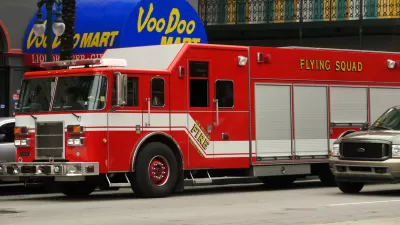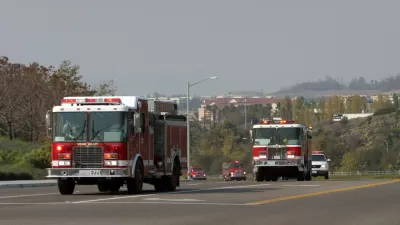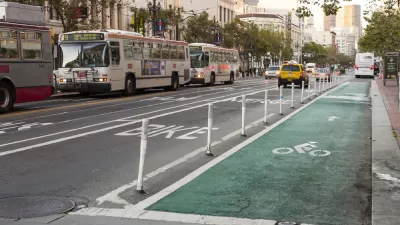Planners and urbanists are familiar with the many instances when fire and life safety codes conflict with quality urban design. The city of San Francisco is currently embroiled in policy conflict over the width of its streets.

"The San Francisco Fire Department has recently fought streetscape improvements and other efforts to make roads safer and more walkable. Even more problematic, the fire department has insisted that in new developments in San Francisco – and we have quite a few of them planned – all roads, including residential side streets, be 30 percent wider than the code minimum of 20 feet of street clearance (typically two 10-foot lanes)," writes San Francisco Supervisor Scott Wiener.
"This type of expansion, in addition to narrowing sidewalks, would result in neighborhood side streets either having 13-foot freeway-size lanes, or having cement barriers in the middle of the street. Either option is the exact opposite of good urban design and neighborhood walkability and livability. Worse, either option would go back to an ugly past we are actively trying to fix."
As an advocate for urban design and livable streets and neighborhoods, Wiener is clearly concerned about the policy agenda of his hometown fire department. But the goals of fire safety and pedestrian safety, says Wiener, do not need to be mutually exclusive:
"Fire departments around the country have an understandable desire to maximize ease of access for large fire trucks, and promoting fire safety is in everyone’s interest. But prioritizing fire truck access in a way that makes streets less safe for pedestrians and other users – and which undermines neighborhood fabric with high-volume, fast-moving traffic – isn’t the right solution."
FULL STORY: Fire Departments Are Standing in the Way of Good Street Design

Planetizen Federal Action Tracker
A weekly monitor of how Trump’s orders and actions are impacting planners and planning in America.

Chicago’s Ghost Rails
Just beneath the surface of the modern city lie the remnants of its expansive early 20th-century streetcar system.

San Antonio and Austin are Fusing Into one Massive Megaregion
The region spanning the two central Texas cities is growing fast, posing challenges for local infrastructure and water supplies.

Since Zion's Shuttles Went Electric “The Smog is Gone”
Visitors to Zion National Park can enjoy the canyon via the nation’s first fully electric park shuttle system.

Trump Distributing DOT Safety Funds at 1/10 Rate of Biden
Funds for Safe Streets and other transportation safety and equity programs are being held up by administrative reviews and conflicts with the Trump administration’s priorities.

German Cities Subsidize Taxis for Women Amid Wave of Violence
Free or low-cost taxi rides can help women navigate cities more safely, but critics say the programs don't address the root causes of violence against women.
Urban Design for Planners 1: Software Tools
This six-course series explores essential urban design concepts using open source software and equips planners with the tools they need to participate fully in the urban design process.
Planning for Universal Design
Learn the tools for implementing Universal Design in planning regulations.
planning NEXT
Appalachian Highlands Housing Partners
Mpact (founded as Rail~Volution)
City of Camden Redevelopment Agency
City of Astoria
City of Portland
City of Laramie




























